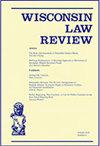公众得到了什么?实验使用与专利交易
IF 0.7
4区 社会学
Q2 LAW
引用次数: 47
摘要
本文讨论了通过专利保护具有商业价值的发明的传统与对自由获取技术信息的强大公共领域作为进一步研究的跳板的需求之间日益加剧的紧张关系。experimental use exemption允许对专利发明进行一些未经授权的研究使用,可以用来缓解这种紧张关系。然而,研究豁免的范围到目前为止已经缩小了联邦巡回法院最近的意见,即即使是基础大学的研究也不能免除侵权责任。这篇文章回到专利法的第一原则——发明和公开的激励——并认为目前的狭隘豁免并没有让公众从专利交易中获益。在本文中,我分析了披露和发明激励对不同类型发明的影响。这篇文章的结论是,部分由于我称之为自我披露和非自我披露的发明类型之间的区别,有可能设计一种experimental use exception,它比当前的限制性原则更有效地促进有用技术的进步。本文章由计算机程序翻译,如有差异,请以英文原文为准。
What Does the Public Get? Experimental Use and the Patent Bargain
This article deals with the increasing tension between the tradition of protecting commercially valuable inventions through patenting and the need for a robust public domain of freely available technical information as a springboard for further research. The experimental use exemption, permitting some unauthorized research uses of patented inventions, might be used to relieve some of this tension. However, the scope of the research exemption has been shrunk so far by recent Federal Circuit opinions that even basic university research is not excused from infringement liability. This article returns to the first principles of patent law - the incentives to invent and to disclose - and argues that the current narrow exemption is not giving the public the benefit of its patent bargain. In this article, I analyze the effects of disclosure and the incentive to invent on different types of inventions. The article concludes that, partly because of distinctions between types of inventions that I dub self-disclosing and non-self-disclosing, it is possible to design an experimental use exception that promotes the progress of the useful arts more effectively than the current restrictive doctrine.
求助全文
通过发布文献求助,成功后即可免费获取论文全文。
去求助
来源期刊

Wisconsin Law Review
Social Sciences-Law
CiteScore
1.00
自引率
16.70%
发文量
0
期刊介绍:
The Wisconsin Law Review is a student-run journal of legal analysis and commentary that is used by professors, judges, practitioners, and others researching contemporary legal topics. The Wisconsin Law Review, which is published six times each year, includes professional and student articles, with content spanning local, state, national, and international topics. In addition to publishing the print journal, the Wisconsin Law Review publishes the Wisconsin Law Review Forward and sponsors an annual symposium at which leading scholars debate a significant issue in contemporary law.
 求助内容:
求助内容: 应助结果提醒方式:
应助结果提醒方式:


